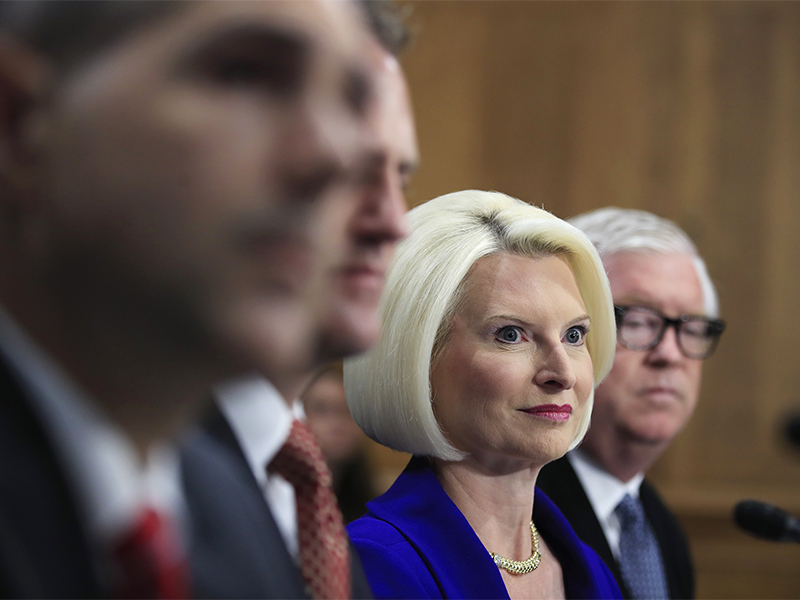VATICAN CITY (RNS) — Serving as ambassador for Donald Trump’s administration is a job that will test the most seasoned of diplomats.
It’s no surprise, then, that Callista Gingrich, the president’s nominee for ambassador to the Holy See, is already being written off by critics as unfit for the job.
How is it possible, the naysayers ask, that a documentary maker who carried out a six-year extramarital affair with former U.S. House Speaker Newt Gingrich is a suitable choice to represent United States’ interests in the Vatican?
Think again.
[ad number=“1”]
Gingrich, whose husband is a major Trump ally, has the major bonus of being able to pick up the phone and relay messages directly to the president.
For the Vatican this is important, particularly given the major disagreements between Pope Francis and the president ranging from climate change to building a wall along the U.S.-Mexico border.
“At a moment of need you need a friend of the president who can talk to him,” a Vatican insider explained.
And there are likely to be some of those moments. Gingrich faces fierce challenges, particularly given Trump’s decision to pull out of the Paris climate accord.
READ: Pope Francis ally says Trump exit from climate accord would be a ‘slap’ in the face
He did so just days after meeting the pope and after he promised to read Francis’ landmark encyclical on protecting the environment. During her Senate Foreign Relations Committee hearing last week, the prospective ambassador struggled to convince skeptical Democrats that the president wants the United States to be an “environmental leader.”
But it’s a mistake to think the Holy See has given up on building a working relationship with the Trump administration. The half-hour private meeting between Francis and the president in the Vatican in May was considered a success by those later briefed on their discussions.
“Channels of dialogue were opened up,” explained one diplomatic source.
READ: Pope Francis gives President Trump some homework at their first meeting
The key challenge for the pope and the Holy See, sources say, is to correctly understand the president’s thinking and to open lines of communication if there are disagreements.
That’s where Gingrich, whose appointment has yet to be confirmed, comes in. While the Holy See operates a formal diplomatic protocol and is used to working with career diplomats, with Trump the old rulebook has been ripped up.
“Her close relationship with President Trump will be important in strengthening our bilateral relations, as was the case when I served as ambassador under President George W. Bush,” said Rep. Francis Rooney, R-Fla., who served as envoy to the Vatican from 2005 to 2008.
[ad number=“2”]
“The Holy See has a unique role in foreign policy through its use of moral persuasion, or ‘soft power.’ Mrs. Gingrich will be in a unique position to work alongside the Catholic Church where United States interests are aligned, including working to protect religious freedom and promoting human rights, as well as fighting against radical Islamic terrorism.”
Newt Gingrich, who has just written a book, “Understanding Trump,” will be an asset here. Sources close to the couple say he plans to split his time between Rome and Washington, allowing him to relay messages back and forth.
The Holy See has diplomatic relations with 183 states across the world and countries appreciate the Vatican as an important listening post. It means the role of an ambassador stationed in Rome is focused on building contacts rather than, say, trade deals or the intricacy of foreign policy.
[ad number=“3”]
“I quickly realized,” said Miguel Diaz, President Obama’s Holy See ambassador from 2009 to 2012, “it is not just what you know and how qualified you may be for a particular assignment that can make a difference, but also who you know in the world of Washington and Vatican relationships. Unlike Callista Gingrich, Diaz said he wasn’t able to pick up the phone to key power players back home.
When in Rome, the Gingriches will be able to oil the wheels of diplomacy at the United States’ ambassadorial residence, a spacious house with a large terrace overlooking beautifully landscaped gardens on Janiculum Hill. It is the perfect setting for those discreet diplomatic dinners where relationships are forged.
The Gingriches are also political big hitters and their presence in Rome is going to shake up the embassy circuit and, at the very least, raise the profile of the U.S.-Holy See relationship.
(Christopher Lamb is The Tablet’s Rome correspondent and a contributor to RNS)





